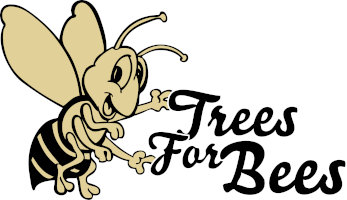

Figure 1. The floral display of tagasaste branches are composed of densely packed flowers in various stages of opening.
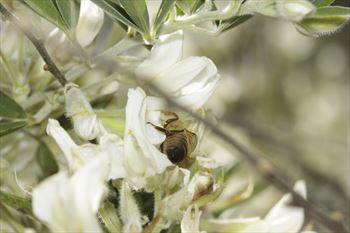
Figure 3. This honey bee may be collecting nectar at the back of the flower through a hole made by bumble bees.
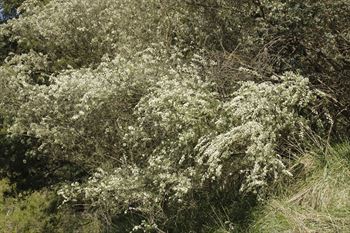
Figure 4. A group of tagasaste trees with branches bending down gracefully and fully loaded with densely packed flowers. All photos (except Figure 5) by LE Newstrom-Lloyd © Trees for Bees NZ.
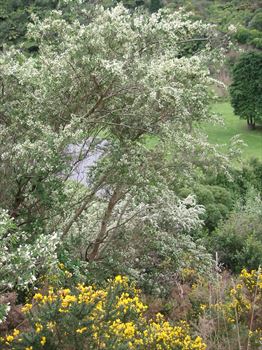
Figure 5. Tagasaste flowering in early spring, growing as a tall shrub with gorse in the foreground. Photo: Frank Lindsay.
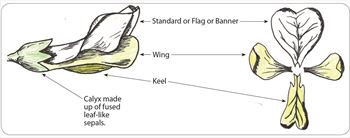
Figure 2. The classic flag blossom (like a pea or bean flower) has five petals wrapping around each other to conceal the pollen and nectar. The diagram on the right shows the five petals pulled apart: the top petal is called the standard, flag or banner. The two side petals, called the wings, enclose the two lower petals, which are fused together in the shape of the keel of a boat. The wings and the keel hold the stamens (pollen) and female parts of the flower under tension so the bee needs to ‘trip’ the flower open to gain access to the pollen and nectar. If the bee is heavy enough, when it lands on the flower the wings will spread apart as the bee pushes down on the keel. This action will release the stamens explosively and throw pollen onto the bee. Once the flower is tripped open it also gives access to the nectar. In general, a plant species with large, strong flag blossoms can only be tripped by big bees like bumble bees but other plant species with small flag blossoms can also be tripped by honey bees and smaller native bees. It depends on the size and strength of the flower in relation to the strength and weight of the bee. This diagram has been adapted from Porter (1967).
Star Performer Status
Chamaecytisus palmensis, called tagasaste or tree lucerne, is in the legume family (Fabaceae). Tagasaste is a significant star performer in New Zealand because it flowers from late winter through early spring when little else is flowering for bees. Tagasaste starts flowering as early as June, peaking from August to September, when bees are emerging from their winter rest to build up colonies.
Each shrub/tree has prolific floral displays. Flowering can continue for up to four months. Cultivated and naturalised tagasaste are important multi-function plants much used by farmers and other landowners, so it is abundant and common everywhere, making it a plentiful and available forage plant for honey bees.
Introduction
One of the puzzling features of tagasaste is that we often find few honey bees foraging at one time on a tree. In other words, it is not what we call a ‘buzz plant’ with a frenzy of numerous honey bees buzzing loudly and covering the whole tree. This is because the flowers are in several different stages of opening along the branch and the flowers have a complex structure that challenge honey bees to gain access to pollen and nectar in the young flowers.
The flowers of tagasaste are ‘closed-access’ flowers in the shape of the familiar ‘flag blossom’ type also found in other members of the legume family such as peas, beans, and clover.
Closed-access ‘flag blossom’ flowers can be a challenge to honey bees because the pollen and nectar are hidden and enclosed inside the centre of the flower enfolded by overlapping petals, as shown in Figure 1. The structure of the flower is illustrated in Figure 2, showing how the three outer petals, namely the banner at the top and the wings on the sides, fold over to conceal the lower two fused petals called the keel. The keel keeps the stamens (male parts with pollen) and pistil (female parts) hidden and under tension.
Access to the concealed pollen and nectar is prevented until the flower is forcibly opened by a big bee. Honey bees have difficulty opening young tagasaste flowers but the stronger and heavier bumble bees can rapidly ‘trip’ the flowers open (Figure 2). Honey bees therefore benefit by the presence of bumble bees tripping the flowers open for them.
Did you know about other ‘flag blossoms’? Many cultivated plants in New Zealand also have ‘flag blossom’ type flowers that are characteristic of the legume family (Fabaceae). For example, other important agricultural and food plants in the legume family include: alfalfa (Medicago sativa) beans (Phaseolus) carob (Ceratonia siliqua) chickpeas (Cicer arietinum) liquorice (Glycyrrhiza glabra) peanut (Arachis hypogaea) peas (Pisum sativum) soybean (Glycine max) A number of species are also weedy pests in different parts of the world, including: black locust (Robinia pseudoacacia) broom (Cytisus scoparius) gorse (Ulex europaeus) kudzu (Pueraria lobata) lupin/lupine (Lupinus spp.)
Names
Names
Which common name to use: tagasaste or tree lucerne?
Chamaecytisus palmensis is usually called tree lucerne but another commonly used name is tagasaste. It is often confused with tree lupin (Lupinus arboreus) and also with another fodder legume, Medicago arborea, also known as tree lucerne.
Another source of confusion is that it can also be confused with lucerne, the pasture crop (Medicago sativa).
To be clear about which plant we mean, we prefer to use tagasaste rather than tree lucerne or lucerne. This is why we try to be particular about using Latin botanical names so we know which plant is referred to.
Pollen
Pollen
To gain access to pollen and nectar, honey bees and bumble bees approach tagasaste flowers differently, according to observations by Webb and Shand (1985). Each flower is long-lived, lasting from four to nine days. They are densely packed on each branch and in several different stages of opening. The pollen is already presented inside the flower bud before it opens but the pollen stays hidden until the flower is tripped. When the flower starts to open, the top petal (banner) recurves upwards to signal to the bees that it is ready. To release the keel and expose the pollen, the flowers have to be forcibly ‘tripped’ open.
It takes considerable force to trip the young flowers fully open. Bumble bees are strong enough but honey bees are not. Bumble bees force their way under the banner petal, spreading the wings apart and pushing down on the keel. These actions liberate the keel and release the tension on the stamens. You can trip mature flowers yourself by pushing on the keel. The stamens are thrown upward explosively with a cloud of pollen dusting the under surface of the bumble bee or your finger.
An explosive mechanism like this does not allow pollen to be collected easily from untripped flowers. Webb and Shand (1985) noticed that honey bees had to wait until bumble bees tripped the young flowers open. These young flowers returned to their former closed position after the bumble bee tripped them, but when older flowers were tripped, they remained fully open, giving honey bees easy access to the leftover pollen and nectar.
Since a multitude of flowers densely cover the whole tree, the gleanings of pollen available in older flowers is still worthwhile for honey bees to collect. Besides, the pollen has high protein; our sample measured at 35% crude protein. While Webb and Shand (1985) concluded that tagasaste is not an important source of pollen for honey bees, New Zealand beekeepers rely on it in many areas that are short of pollen and nectar otherwise.
Nectar
Nectar Nectar production is located inside the keel at the base of the stamens, so it is also hidden. The nectar exudes on the outside of the staminal tube, which is formed by the fusion of stalks (filaments) of the 10 stamens. Webb and Shand (1985) bagged flowers to exclude visitors, and were able to draw off 2.6 μl (microliters) of nectar from one-week-old flowers that had not been visited by bees.
For successful pollination of the flower, the bees must approach the front of the flower, trip it open and thereby deposit pollen on the stigma (female part). However, to access nectar, bumble bees often cheat these types of ‘flag blossoms’ by going around to the back of the flower and cutting a hole in the calyx (sepals) (Figure 2). This action, called nectar robbing, does not deposit pollen on the stigma but the bumble bees have avoided the work of tripping the flowers. Honey bees also go the back of the flower to take advantage of these same bumble bee holes for easy access to nectar (Figure 3).
Webb and Shand’s study (1985) found that 93 percent of honey bee visits for nectar were through holes at the back of the flower. However, some honey bees also collected nectar from the front or side of older flowers already tripped by bumble bees. The profusion of long-lived flowers on each tree over four months means that the nectar is worthwhile for honey bees when there are scarce alternative nectar sources (Figure 4).
Multiple Uses
Multiple uses
Tagasaste is widely cultivated throughout New Zealand because it is an outstanding multi-purpose shrub/tree suitable for fodder for livestock (high protein 18–25%); pollen for bees (high protein 35%); shade and shelter for stock and horticulture; food for native birds; habitat for native and exotic birds; a nurse crop for native plants; and for increased soil fertility through nitrogen fixation.
Tagasaste is also ideal for a low-level wind break; wind and water erosion control; coppiced firewood production, and a green fire break because it is fire resistant as a growing plant. It excels in drought-prone areas and dry hill country because it is drought hardy, with roots extending down at least 10 metres. Adult plants are moderately frost tolerant (-6°C) but the flowers are damaged by frost.
Tagasaste has only a few disadvantages: it is highly palatable to pests (possum, hares, rabbits): intolerant of shade; intolerant of poor drainage or waterlogging, subject to root rot; and vulnerable to ‘root rock’ in winds if allowed to get too leggy. In warmer districts, care must be taken that honey bee colonies are not stimulated by tagasaste plants causing the queens to lay eggs out of season (Newcombe, 1999), particularly if a winter broodless period is desired.
Planting Advice
Planting advice
Tagasaste is a small spreading evergreen shrub/tree that can grow in excess of one to two metres in its first year, with mature plants three to four metres high, and up to seven metres. It is endemic to the Canary Islands, Spain and has been introduced around the world particularly in New Zealand and Australia as a fodder crop. It has naturalised in New Zealand and can be found in waste areas and along roadsides.
Tagasaste is a fast-growing shrub/tree that is easy to propagate and spreads naturally by seeds (Figure 5). Small seedlings can be susceptible to browsing damage and frost, so larger seedlings 30–50 cm high should be used. Trees should be protected from browsing by livestock for at least two to three years. When trees are young, sheep will eat the bark and kill the tree if it is not protected. However, once the tree is well established, sheep can browse all year and the tree has remarkable capacity to recover from defoliation. While a fast-growing shrub, tagasaste can persist for up to 30 to 40 years if well managed, which includes periodic pruning/topping to manage its size.
Tagasaste has been used in Trees for Bees projects as part of shelterbelts, on track margins, cuttings and escarpments, in paddock corners, and to assist with land stabilisation. We have worked with beekeeper Barry Foster, who uses the technique of planting a row of tagasaste at the top of steep eroded banks to allow the seeds to spread down the slope, where they will geminate and grow into trees covering the slope.
Planting tagasaste is a good option wherever it is a useful plant for the landowner but it can also be useful solely for bee forage, especially when honey bees can gain better access to pollen and nectar if bumble bee populations are available to help with the work of tripping the younger flowers.
What did Walsh (1967) 1978 say?
Tree Lucerne (Cytisus proliferus). (OLD NAME new name is Chamaecytisus palmensis)
Commonly known as Tagasaste, used as a rapidly growing hedge plant attaining a height of up to 7 m.
The blooms are produced in profusion along the stems of the previous year's growth and are creamy white in colour. In the Auckland and North Auckland districts, tree lucerne comes into flower in June and remains in bloom until September.
This is a valuable bee plant in the South Island, but in the Auckland district results in too much stimulation with the result that queens begin laying and large numbers of out of season bees are produced with consequent heavy inroads into the stores of colonies.
Tree lucerne in this district is subject to tree borer which considerably shortens the life of the trees. When the trees are grown as a hedge plant and kept cut, flowering is delayed for a number of weeks.
A good supply of deep but dull creamy yellow pollen is obtained from tree lucerne. The honey is white in colour and mild flavoured.
Quoted from Page 7 to 8 in the book Nectar and Pollen Sources of New Zealand by R.S. Walsh first published in 1967 and second edition in 1978 edited by Trevor Walton with assistance from David Williams, Rotorua.
Exotic
True
Native
False
References
References
Dann, P. (1986). Tagasaste (tree lucerne). Agfacts, NSW Agriculture, Order No. H6.AE.2, AGDEX 431/622. 6pp. www.agric.nsw.gov.au.
Francisco-Ortega, J., & Jackson, M. T. (1991). Historical aspects of the origin and distribution of tagasaste (Chamaecytisus proliferus (L. Fil.) Link ssp. palmensis (Christ) Kunkel), A fodder tree from the Canary Islands. Journal Adelaide Botanical Garden, 14(1), 67–76.
Hawke’s Bay Regional Council. (2002). Tagasaste (Tree Lucerne): Chamaecytisus palmensis. Land Management. Conservation Trees. Environment Topics. Hawke’s Bay Regional Council. www.hbrc.govt.nz.
Newcombe, G. (1999). Tagasaste. New Zealand Tree Crops Association. http://www.treecrops. org.nz/crops/shelter/tagasaste/
Porter, C. L. (1967). Taxonomy of flowering plants. Diagram 237: Descriptions of leguminous plants (page 300). San Francisco: W.H. Freeman and Company.
Stace, C. (2003). Uses and management of tagasaste (Chamaecytisus palmensis). Sustainable Options. Land Management 19. Bay of Plenty Regional Council. www.envbop.govt.nz.
Webb C. J., & Shand, J. E. (1985). Reproductive biology of tree lucerne (Chamaecytisus palmensis, Leguminosae). New Zealand journal of botany, 23(4), 597–606. DOI: 10.1080/00288 25X.1985.10434230.